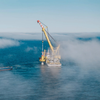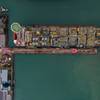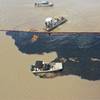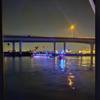Efficient Coordination of Mega-ship Calls at Hamburg Port
The number of ultra large vessels calling at the Port of Hamburg has been on the increase for years. This is resulting in some major challenges for the port operators, shipping companies and authorities. With the introduction of the Nautical Terminal Coordination (NTK), there is now a body to handle the centralised operational coordination of mega-ship calls for the first time – long before a vessel proceeds up the estuary of the river Elbe. It draws on the experience and the structures of the Feeder Logistics Center (FLZ).
Since 2008, the number of ultra large vessels calling at the Port of Hamburg has increased from 621 to 989. This includes not only container ships, but also cruise ships, bulk carriers and other vessels, all of which are subject to different restrictions when navigating the estuary to and from Hamburg, caused by, for example, the water level in the river Elbe or the width of the navigation channel. These restrictions have to be taken into account when ship calls are being processed and this results in there being interdependency on the arrival or departure of other ships. With Nautical Terminal Coordination, there is now a coordinating body that monitors the interdependency of all ship entries in Northern Europe and can then identify conflict situations and reduce the impact on the entire port system.
Dr. Stefan Behn, member of the Executive Board of HHLA and responsible for the Container segment, stresses the importance of Nautical Terminal Coordination: “We are continuing the successful work of the Feeder Logistics Center with Nautical Terminal Coordination. Both of these are prime examples of the cooperative approach that we adopt in order to jointly rise to the challenges we face in the Port of Hamburg – not only in relation to container ships, but also to much more besides. Everyone involved benefits from the work of Nautical Terminal Coordination. They refrain from trying to assert their own specific interests here and there, because this allows the system as a whole to operate more smoothly.”
Peter Zielinski, Managing Director of EUROGATE Container Terminal Hamburg GmbH, emphasises the uniqueness of Nautical Terminal Coordination: “It made sense to set up Nautical Terminal Coordination and it was also necessary, irrespective of the impending judgement regarding the dredging of the navigation channel. This is because the number of mega-ship calls has increased significantly in recent years. We are therefore delighted to see the four Hamburg container terminals being joined by Hansaport, the biggest bulk cargo terminal in Hamburg, in Nautical Terminal Coordination. The involvement of other shipping points would also make sense and would be welcomed.”
Heinrich Goller, Managing Director of FLZ/NTK, describes the facility’s character: “It’s the job of Nautical Terminal Coordination to pool communication channels and to identify the interdependency of decisions made in mega-ship handling early on and to resolve these issues as far as is possible. In contrast to public port authorities, we already track the ships on their approach routes, for example all the way from Gibraltar and in particular from the previous ports. We are therefore able to spot potential disruptions very early on and to then develop operation-based proposals. We actively coordinate the workflows and develop demand situations from the perspective of the Hamburg terminals, which we reach agreement on with the relevant public port authorities. By acting as the central point of contact, we eliminate bilateral communication for the other parties on the one hand and avoid operational friction on the other.”
Harbour Master Jörg Pollmann comments on Nautical Terminal Coordination: “We are delighted to now see Nautical Terminal Coordination up and running. It takes the pressure off the Vessel Traffic Service Centre, because it allows us to focus on what are actually our official duties. We, too, are therefore keen to see more shipping points getting involved in Nautical Terminal Coordination.”
Nautical Terminal Coordination has been working since the start of October on the basis of a two-shift system. A third shift is set to be introduced as soon as possible, and preparations are currently under way to increase staff numbers to accommodate this. Three employees currently work for NTK. NTK’s duties for the Hamburg container terminals and Hansaport include cross-terminal coordination of the preliminary planning, approach guidance and departure planning of mega-ships in the Port of Hamburg. NTK will also assume a central and active communication role in relation to the Vessel Traffic Service Centre.
How does NTK work? A typical traffic situation that occurred this summer and which happens in the Port of Hamburg on a regular basis serves as an example of the complexity of NTK’s coordination duties:
Two container mega-ships and a bulker are coming in with the tide, while two container ships head out. The vessels are between 300 and 400 metres long and up to 56 metres wide. NTK staff monitor the ships from various terminals and calculate the possible passing options as well as the vessels’ terminal arrival and departure times on the basis of their individual draughts. There are additional requirements that also have to be taken into account: When can the vessels pass under the Köhlbrand Bridge? Where may the vessels pass each other? What happens if the water levels change? Additionally various aspects also have to be considered: When will the ship currently docked at the berth be ready to go? For which shift has a terminal ordered dockers with the intention of starting work on a ship? What is the optimum operational arrangement? NTK staff members must constantly consider the effect that a decision regarding one vessel might have on the operational situation of other vessels and must update their calculations for these ships accordingly. NTK monitors the ships throughout Northern Europe long before they arrive and is therefore in a position to devise coordinated operational solutions in good time. It shares these solutions with the public port authorities, who then handle the traffic situation on the river Elbe and who ultimately decide what route a vessel is to take.









